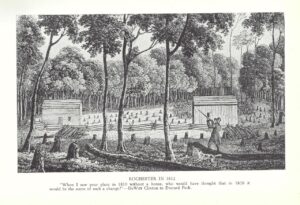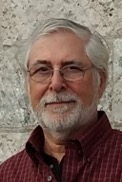 "Rochester in 1812," from Ulysses Prentiss Hedrick, A History of Agriculture in the State of New York (1933). Courtesy of the New York State Agricultural Society
"Rochester in 1812," from Ulysses Prentiss Hedrick, A History of Agriculture in the State of New York (1933). Courtesy of the New York State Agricultural Society
I have been struggling with a dilemma for months – how (and if) to tell the story of a loving father whose actions would lead to unintended and tragic outcomes for his family. When encountering very unusual and difficult family information in your research, what do you choose to publish? In seeking community comment and guidance, I will outline the core issues, but use pseudonyms and avoid other identifying information. I am aware of no genealogy on-line or in print that encompasses this family; it is not in my direct line, but related.
“Edward Winston” and his family, then consisting of a wife and four sons, moved to western New York early in the nineteenth century to newly-opened lands in “Genesee Country” to carve a farm from the wilderness. I suspect that Edward’s wife, “Betty,” died in the hard years following settlement. Old family records identify some of the unusually-named children of this family, which enabled their definitive identification in land and census records. There was, however, one child in census records not identified in family history: in 1850, the census (and each to follow) revealed why that may have been – a son, “Jesse,” the first born, was recorded as “idiot.” The other children had by then married and moved further west.
Born abound 1820, probably of a second wife, a girl was enumerated who seems also to appear in 1830 and 1840 censuses. In the 1850 census, in addition to the first identification of Jesse, above, there were two additional surprises. Edward, then 83, had recently taken a new wife, “Sandra,” age 34; the girl, who (would have then been 30) disappeared and a previously-unrecorded son named “Harrison” appeared … of the same age. No other record of any daughter has been found.
Edward wrote his will around 1853, and died at age 90 in 1857. At a time and in circumstances when there was no institutional care, he had devised a strategy for the care of his disabled son, Jesse. Sandra was to care for Jesse In return for one-third of his estate; the other two-thirds went to Harrison with the same condition, that he would care for Jesse for the rest of his days. At the time, probably to clear title, the two other living sons, “Clark” and “Edmund,” long since established on their own farms to the west, were grantors of their father’s land to Sandra and Harrison.
At a time and in circumstances when there was no institutional care, he had devised a strategy for the care of his disabled son, Jesse.
Such loving plans of a father for care of his firstborn were, however, to have a dark outcome for others. Research unwound painfully; the next event in the saga was Harrison’s death in 1864. Further research uncovered a local newspaper article about the gruesome circumstances of Harrison’s death – he had been found … naked … hanging from the rafters of his home. It reported the results of an inquest concluding that he had attempted suicide a year earlier, and had been despondent following the remarriage of his step-mother Sandra. Given the apparent switch in gender in the census, and the circumstances of his death … was Harrison transgender, before there was such a cultural construct?
With his death (and perhaps earlier, following his attempted suicide in 1863) the remaining brothers stepped in. The 1865 New York State census revealed that Edmund and family had relocated back to his father’s farm; Clark was appointed executor of Harrison’s estate.
At this point, circumstances and events come together to raise questions that invite speculative conclusions. The 1865 census in Edmund’s family also enumerated an infant son named “Stephen,” born in 1864. Later records relate that Stephen was a half-brother of Edmund’s other children. If Edmund initially returned alone in 1863 to deal with the crisis caused by Harrison’s attempted suicide, who was the mother of Stephen? Sandra? She could not be found in the 1865 or subsequent censuses; she would have been of questionable child-bearing age.
Family turmoil was likely why Jesse was found living away from his father’s home, the only time, in 1865, seemingly with another relative. He was back at his father’s farm in 1870 and 1875, living with brother Edmund and family. Stephen died at age 11 in 1875; Jesse died in early 1880, at the age of 80, certainly a long life under the circumstances, an unusual story of family care and love. However, the census of that year also revealed the dissolution of Edmund’s marriage – his wife had left and moved to Ohio.
While I may later choose to publish these events, I will value and weigh comment.
Share this:

About Ross Williams
Retired from a Human Resources management position with a major corporation, Ross has degrees in Economics from Binghamton University and Industrial Relations from Cornell. A long-time family genealogist, his American ancestry is early British Isles immigrants—all ancestors born after 1800 resided in rural Washington County, New York. His current focus is on documenting this little researched line of the Williams family that migrated from New England to the Argyle Patent in Eastern New York after the Revolution, and on to Western New York and beyond in succeeding generations.View all posts by Ross Williams →